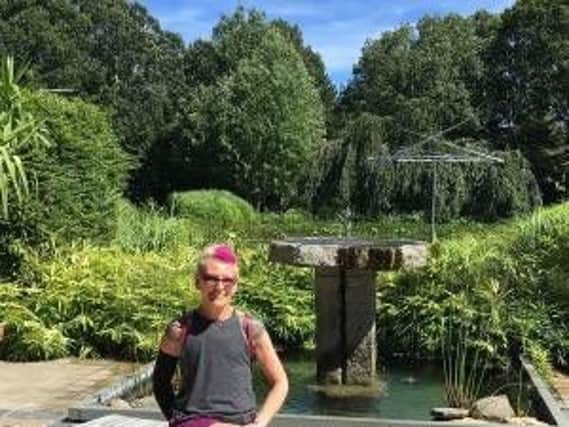Lancashire mum's '˜pay day check' idea helped her beat breast cancer


Sue Cook, 62, discovered she had an aggressive form breast cancer after getting into the habit of checking for lumps every pay day.
The former art teacher who is now chief examiner for Foundation Arts and Design at University of the Arts London, started checking her breasts for lumps when she turned 50.
Advertisement
Hide AdAdvertisement
Hide Ad“Up until that point, it hadn’t really come into my consciousness,” she says. “It’s so simple, but I realised I would need a trigger to remind myself to check for lumps regularly, so I came up with the idea to check every pay day – as I always know when that comes around!
“And I’m so pleased I did, because I went from feeling nothing in the September, to finding a little knot and then my breast caving in that October!
“I made an appointment with my GP after feeling it – it wasn’t a lump as such, it was more like a little knotted string. But that morning my breast just caved in and they fast-tracked me to Ormskirk Hospital – it had grown so fast.
“I had a mammogram, ultrasound and biopsy, and it turned out to be a rare and very aggressive form of cancer. There was more than one tumour in my right breast, and a follow-up found that there were cancer cells in my lymph nodes.”
Advertisement
Hide AdAdvertisement
Hide AdSue underwent eight sessions of chemotherapy over six months in 2009, as well as radiotherapy and a radical mastectomy to remove all of the tissue, muscle and lymph nodes in her right breast.
She then agreed to have her left breast removed in the summer of 2010, to reduce the risk of developing cancer there.
“I decided against reconstruction because the treatment had made me incredibly ill, and it had been such a gruelling and traumatic experience, I felt my body had gone through enough,” she recalls.
“It didn’t bother me, it was just an adjustment. I went from being a D-cup to having a washboard chest, but it’s not important. Some people find the change incredibly difficult, but I was just grateful to be alive – I’m not bothered about my boobs.”
Advertisement
Hide AdAdvertisement
Hide AdShe did, however, opt to have a beautiful grey and black ‘lace’ design tattoo on her chest – which made national headlines – to cover her scars.
She explains: “I had been given a 40 per cent chance of surviving more than five years, so when I reached that milestone, I celebrated with the tattoo.
“I got sponsored and raised £1,800 for Cancer Research UK, and every time I see it, it puts a smile on my face.”
Sue has now been in remission for seven years, but is still living with some of the effects of the intensive treatment she went through, including lymphoedema.
Advertisement
Hide AdAdvertisement
Hide AdShe’s thankful for the support she’s received as an outpatient of St Catherine’s Hospice in Lostock Hall. Sue started visiting the charity’s onsite Woodside Clinic to treat lymphoedema in her arms – a chronic condition which causes swelling in the body’s tissues; sometimes a result of cancer treatment.
“Because of the treatment and everything I was taught about lymphoedema at St Catherine’s, I’m now able to manage my symptoms at home,” she explains. “It has made such a difference to my quality of life. I feel great.”Secondary lymphoedema affects around one in five women after breast cancer treatment, caused by damage to the lymphatic system, or problems with the movement and drainage of fluid in the lymphatic system.
Symptoms include swelling and aching, and if left untreated or if the swelling gets infected, cellulitis or septicaemia can develop.
Sue, a mum-of-four and grandma-of-four, says finding the Woodside Clinic at St Catherine’s online, and being referred there by her GP made all the difference.
Advertisement
Hide AdAdvertisement
Hide Ad“I had no idea about how it all worked until I went to St Catherine’s,” she says. “They measured me for compression sleeves to keep the lymphatic vessels moving and reduce the swelling, and taught me about skin care regimes and moisturisers.
“They also educated me about preventative measures to reduce the risk of infection, such as always wearing rubber gloves when washing up or gardening, and how to recognise the signs of infection.
“They also taught me massage techniques and deep breathing, known as Simple Lymphatic Drainage (SLD) which helps open up the lymph system to flow through the body. I do that daily now – I’ve got it down to a fine art so it only takes me 15 minutes.”
Sue also accessed specialist laser therapy through St Catherine’s, as well as compression pump treatments, and the drainage massages by professionals at the charity.
Advertisement
Hide AdAdvertisement
Hide AdSue, from Wrightington, was discharged in July last year, but still relies on the techniques and tips she learnt at St Catherine’s to manage her lymphoedema symptoms.
“Going there has made such a difference and just really increased my understanding of the condition,” she says. “In terms of the cancer, I have check-ups every six months and scans – they’re keeping a good eye on me.
Debbie Murphy, lymphoedema services manager at the Woodside Clinic, said: “We have a range of therapies available, depending on the location and severity of the lymphoedema. Our team will always design a programme of treatments best suited to the individual which promotes as much independence as possible.
“Our aim is to improve symptoms of lymphoedema, help patients understand and cope with their treatments, and advise them about ways to self-manage the condition – all in all, to help improve their quality of life.”